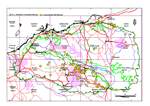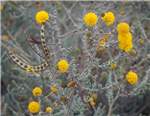Click on images
to enlarge



Photographer: B.R. Maslin

Photographer: B.R. Maslin

Photographer: B.R. Maslin
, BRM 8687, FC_sml.jpg)
Seed from one herbarium voucher. Scale in mm. Photographer: F. McCallum
Botanical name
Acacia adoxa Pedley var. adoxa, Contr. Queensland Herb. 11: 6 (1972)
Common name
Grey Whorled Wattle
Aboriginal name
Pirarr-pirarr (Nyangumarta)
Description
Dense, compact, much-branched, spreading, procumbent, hairy shrubs 15-50 (-75) cm tall and 0.3-1.1 m across. Branchlets densely velvety-hairy, the hairs short, straight and wide-spreading to slightly retrorse. Phyllodes arranged in whorls (usually 6-10 phyllodes per whorl), ±terete to flattened, usually (1.5-) 2-5 (-7) mm long, about 0.3-0.5 mm wide, ascending to erect, straight or very shallowly incurved and commonly slightly recurved at apex, smoky grey or blue to grey-green or blue-green, densely white hairy (hairs similar to those on branchlets except slightly shorter); indistinctly 1-nerved below; the apex not or scarcely uncinate and rather abruptly contracted to a very short, non-spiny point. Inflorescences simple; peduncles (3-) 6-18 mm long, hairs similar to those on branchlets; heads globular, large (about 10 mm in diameter when fresh), bright golden, (20-) 25-35 (-50)-flowered. Flowers 5 or 6-merous; calyx dissected into narrowly triangular or linear lobes; petals finely striate (observe at x10 magnification or higher), hairy. Pods often present at the same time as the flowers, narrowly oblong, flat but rounded over seeds along midline, not constricted between seeds, 2.5-6 cm long, 6-9 mm wide, papery to thinly leathery, sessile or with a very short stalk about 2 mm long, splitting first along one edge, straight to shallowly curved, sticky with a delicate resinous odour, glabrous, mid-brown except darker brown over seeds, bright green when young, margins thickened. Seeds transverse to slightly oblique in the pods, obloid to ellipsoid, about 4 mm long, 3-3.5 mm wide, slightly shiny, black.
Characteristic features
Dwarf, compact, spreading, hairy, sub- shrubs 15-50 (-75) cm tall, crowns smoky grey or blue to grey-green or blue-green. Branchlets densely velvety hairy, the hairs short, straight and wide-spreading to slightly retrorse. Phyllodes arranged in whorls (6-10 per whorl), short (mostly 2-5 mm long), hairs similar to branchlets except slightly shorter. Heads large (about 10 mm in diameter when fresh), bright golden, on long peduncles (mostly 6-18 mm long); petals finely striate, hairy. Pods broad (6-9 mm wide), flat, rounded over seeds along midline, sticky.
Distribution and ecology
Widespread in arid and sub- tropical regions where it extends from the Barlee Range through the Pilbara, northern Little Sandy Desert and western Great Sandy Desert to the Kimberley region in Western Australia, eastward to western Northern Territory. It grows in sand (commonly lateritic) and in shallow rocky soil. In the Pilbara var. adoxa is most common south of the Fortescue River (it is common in the Hamersley Range) and to the east of Port Hedland. It grows on rocky hills and footslopes with a pebbly surface strew amongst spinifex (Triodia spp.).
Flowering and fruiting period
Flower from April to September (occasionally in February) with the main flush from May to July and in September. Pod with mature seeds have been collected from August to November. It is common in this variety for pods to be present on the plants at the same time as the flowers.
Variation
A collection from the Abydos-Woodstock Reserve has unusually short hairs on its branchlets and phyllodes, and atypically short peduncles (3-4 mm long). A collection from near Mt Farquhar has similar phyllode hairs but otherwise appears similar to typical var. adoxa except that its phyllodes are recorded as being bright green. A collection from the mid-slope of Mt Meharry is unusual in that there is up to 15, longer than normal phyllodes (reaching 10-12 mm in length) in the whorls along the main stem.
Taxonomy
Acacia adoxa comprises two varieties, var. adoxa and var. subglabra, both of which occur in the Pilbara, but the former is by far the more common (see var. subglabra for distinguishing features).
Affinities
The only other common Pilbara Acacia with whorled phyllodes is A. spondylophylla which is readily recognized by its distinctive curry odour (at least when fresh), generally longer, bright green phyllodes, smooth (not striate) petals and undulate pods. Hybrids between var. adoxa and A. spondylophylla occur in a few places (e.g. central Hamersley Range and near Nullagine); see A. adoxa var. adoxa x spondylophylla. They occur at a low frequency in populations of the two parents and are most readily recognized in the field by their crown foliage which is a dull greenish colour (phyllodes bright green in A. spondylophylla and grey to blue-green in var. adoxa).
Notes
In some places in the Pilbara (e.g. Joffre Falls) var. adoxa shows prolific regeneration from seed following fire.
This very attractive variety has horticultural potential as a ground cover, especially for rockery plantings.
Conservation status
Not considered rare or endangered.
Origin of name
It species name is possibly derived from the Greek adoxos (disreputable, disgraceful) but it is not know why such an inappropriate name was used for such an attractive plant.
